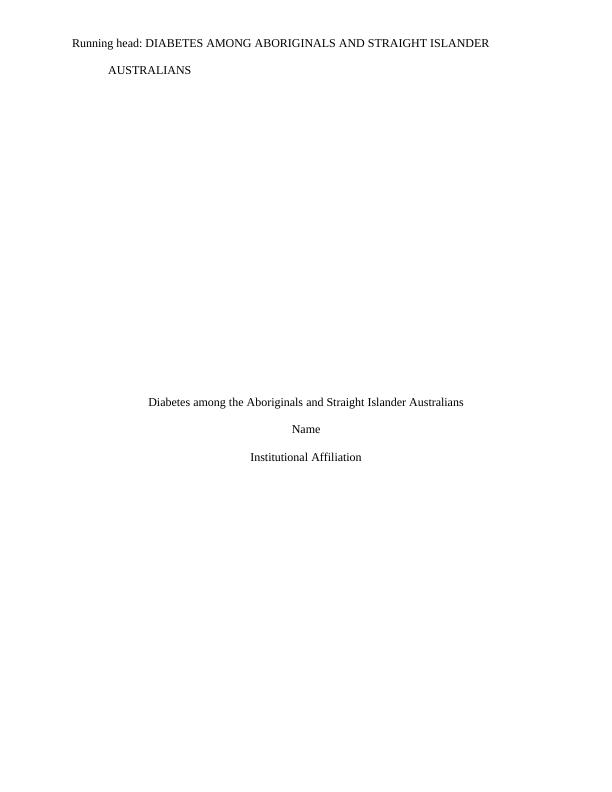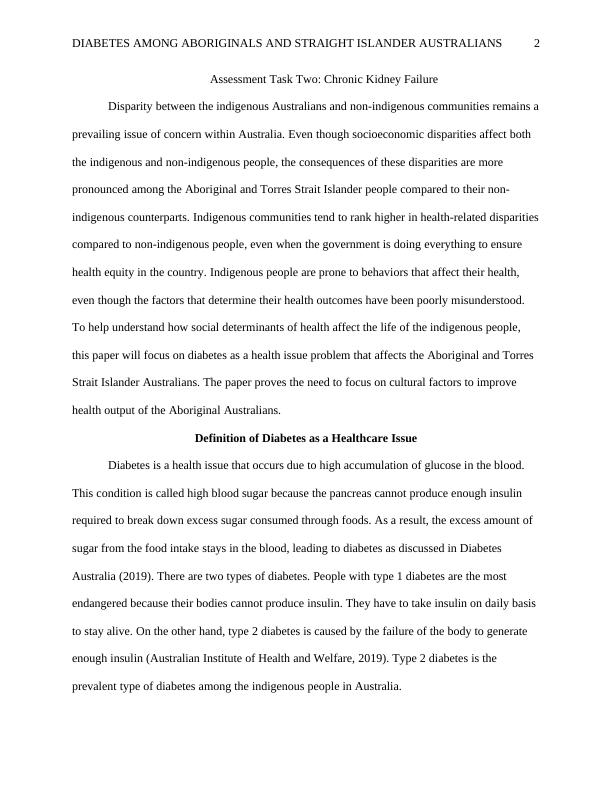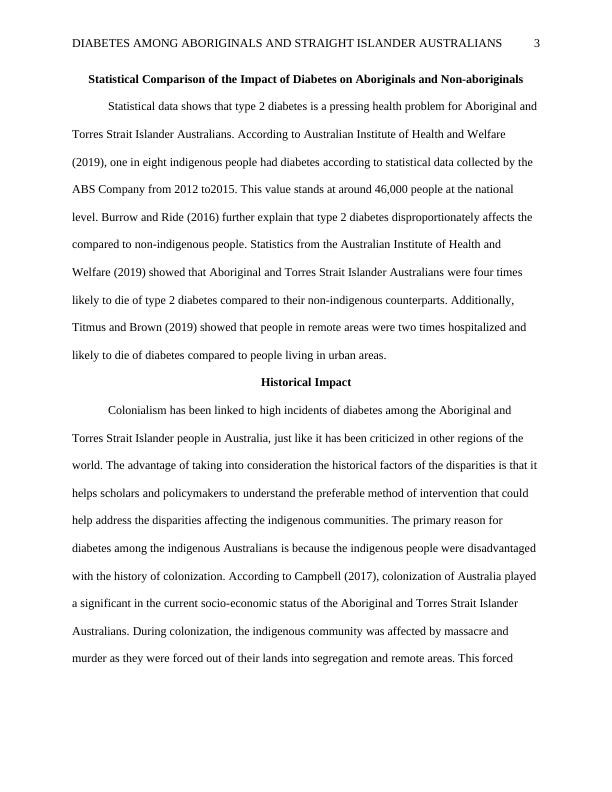Diabetes Among Aboriginals and Straight Islander Australians
Added on 2022-11-01
8 Pages2153 Words125 Views
Running head: DIABETES AMONG ABORIGINALS AND STRAIGHT ISLANDER
AUSTRALIANS
Diabetes among the Aboriginals and Straight Islander Australians
Name
Institutional Affiliation
AUSTRALIANS
Diabetes among the Aboriginals and Straight Islander Australians
Name
Institutional Affiliation

DIABETES AMONG ABORIGINALS AND STRAIGHT ISLANDER AUSTRALIANS 2
Assessment Task Two: Chronic Kidney Failure
Disparity between the indigenous Australians and non-indigenous communities remains a
prevailing issue of concern within Australia. Even though socioeconomic disparities affect both
the indigenous and non-indigenous people, the consequences of these disparities are more
pronounced among the Aboriginal and Torres Strait Islander people compared to their non-
indigenous counterparts. Indigenous communities tend to rank higher in health-related disparities
compared to non-indigenous people, even when the government is doing everything to ensure
health equity in the country. Indigenous people are prone to behaviors that affect their health,
even though the factors that determine their health outcomes have been poorly misunderstood.
To help understand how social determinants of health affect the life of the indigenous people,
this paper will focus on diabetes as a health issue problem that affects the Aboriginal and Torres
Strait Islander Australians. The paper proves the need to focus on cultural factors to improve
health output of the Aboriginal Australians.
Definition of Diabetes as a Healthcare Issue
Diabetes is a health issue that occurs due to high accumulation of glucose in the blood.
This condition is called high blood sugar because the pancreas cannot produce enough insulin
required to break down excess sugar consumed through foods. As a result, the excess amount of
sugar from the food intake stays in the blood, leading to diabetes as discussed in Diabetes
Australia (2019). There are two types of diabetes. People with type 1 diabetes are the most
endangered because their bodies cannot produce insulin. They have to take insulin on daily basis
to stay alive. On the other hand, type 2 diabetes is caused by the failure of the body to generate
enough insulin (Australian Institute of Health and Welfare, 2019). Type 2 diabetes is the
prevalent type of diabetes among the indigenous people in Australia.
Assessment Task Two: Chronic Kidney Failure
Disparity between the indigenous Australians and non-indigenous communities remains a
prevailing issue of concern within Australia. Even though socioeconomic disparities affect both
the indigenous and non-indigenous people, the consequences of these disparities are more
pronounced among the Aboriginal and Torres Strait Islander people compared to their non-
indigenous counterparts. Indigenous communities tend to rank higher in health-related disparities
compared to non-indigenous people, even when the government is doing everything to ensure
health equity in the country. Indigenous people are prone to behaviors that affect their health,
even though the factors that determine their health outcomes have been poorly misunderstood.
To help understand how social determinants of health affect the life of the indigenous people,
this paper will focus on diabetes as a health issue problem that affects the Aboriginal and Torres
Strait Islander Australians. The paper proves the need to focus on cultural factors to improve
health output of the Aboriginal Australians.
Definition of Diabetes as a Healthcare Issue
Diabetes is a health issue that occurs due to high accumulation of glucose in the blood.
This condition is called high blood sugar because the pancreas cannot produce enough insulin
required to break down excess sugar consumed through foods. As a result, the excess amount of
sugar from the food intake stays in the blood, leading to diabetes as discussed in Diabetes
Australia (2019). There are two types of diabetes. People with type 1 diabetes are the most
endangered because their bodies cannot produce insulin. They have to take insulin on daily basis
to stay alive. On the other hand, type 2 diabetes is caused by the failure of the body to generate
enough insulin (Australian Institute of Health and Welfare, 2019). Type 2 diabetes is the
prevalent type of diabetes among the indigenous people in Australia.

DIABETES AMONG ABORIGINALS AND STRAIGHT ISLANDER AUSTRALIANS 3
Statistical Comparison of the Impact of Diabetes on Aboriginals and Non-aboriginals
Statistical data shows that type 2 diabetes is a pressing health problem for Aboriginal and
Torres Strait Islander Australians. According to Australian Institute of Health and Welfare
(2019), one in eight indigenous people had diabetes according to statistical data collected by the
ABS Company from 2012 to2015. This value stands at around 46,000 people at the national
level. Burrow and Ride (2016) further explain that type 2 diabetes disproportionately affects the
compared to non-indigenous people. Statistics from the Australian Institute of Health and
Welfare (2019) showed that Aboriginal and Torres Strait Islander Australians were four times
likely to die of type 2 diabetes compared to their non-indigenous counterparts. Additionally,
Titmus and Brown (2019) showed that people in remote areas were two times hospitalized and
likely to die of diabetes compared to people living in urban areas.
Historical Impact
Colonialism has been linked to high incidents of diabetes among the Aboriginal and
Torres Strait Islander people in Australia, just like it has been criticized in other regions of the
world. The advantage of taking into consideration the historical factors of the disparities is that it
helps scholars and policymakers to understand the preferable method of intervention that could
help address the disparities affecting the indigenous communities. The primary reason for
diabetes among the indigenous Australians is because the indigenous people were disadvantaged
with the history of colonization. According to Campbell (2017), colonization of Australia played
a significant in the current socio-economic status of the Aboriginal and Torres Strait Islander
Australians. During colonization, the indigenous community was affected by massacre and
murder as they were forced out of their lands into segregation and remote areas. This forced
Statistical Comparison of the Impact of Diabetes on Aboriginals and Non-aboriginals
Statistical data shows that type 2 diabetes is a pressing health problem for Aboriginal and
Torres Strait Islander Australians. According to Australian Institute of Health and Welfare
(2019), one in eight indigenous people had diabetes according to statistical data collected by the
ABS Company from 2012 to2015. This value stands at around 46,000 people at the national
level. Burrow and Ride (2016) further explain that type 2 diabetes disproportionately affects the
compared to non-indigenous people. Statistics from the Australian Institute of Health and
Welfare (2019) showed that Aboriginal and Torres Strait Islander Australians were four times
likely to die of type 2 diabetes compared to their non-indigenous counterparts. Additionally,
Titmus and Brown (2019) showed that people in remote areas were two times hospitalized and
likely to die of diabetes compared to people living in urban areas.
Historical Impact
Colonialism has been linked to high incidents of diabetes among the Aboriginal and
Torres Strait Islander people in Australia, just like it has been criticized in other regions of the
world. The advantage of taking into consideration the historical factors of the disparities is that it
helps scholars and policymakers to understand the preferable method of intervention that could
help address the disparities affecting the indigenous communities. The primary reason for
diabetes among the indigenous Australians is because the indigenous people were disadvantaged
with the history of colonization. According to Campbell (2017), colonization of Australia played
a significant in the current socio-economic status of the Aboriginal and Torres Strait Islander
Australians. During colonization, the indigenous community was affected by massacre and
murder as they were forced out of their lands into segregation and remote areas. This forced

End of preview
Want to access all the pages? Upload your documents or become a member.
Related Documents
Diabetes among Aboriginal and Torres Strait Islander people in Australialg...
|8
|2145
|210
Illustrate Burden Of Diabetes Aboriginallg...
|8
|2043
|41
Aboriginal and Torres Strait Islander deaths are significantly more likely to die in their native Australians than their non-indigenous counterpartslg...
|8
|1791
|165
Diabetes in Australia: Impact on Aboriginal and Torres Strait Islander Australianslg...
|8
|2143
|200
Assignment On Health Disparities Of Aboriginal Reportlg...
|12
|2760
|16
Diabetes Mellitus Australia Research Paper 2022lg...
|8
|2400
|35
